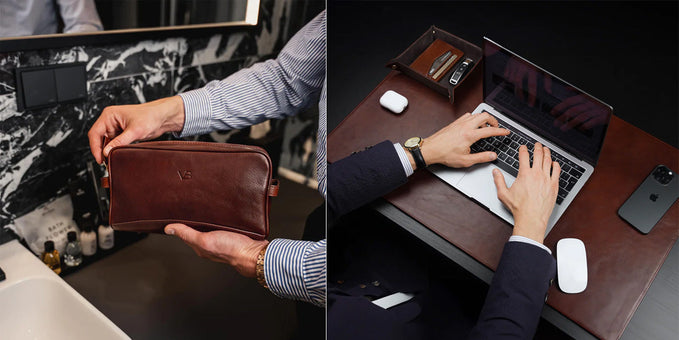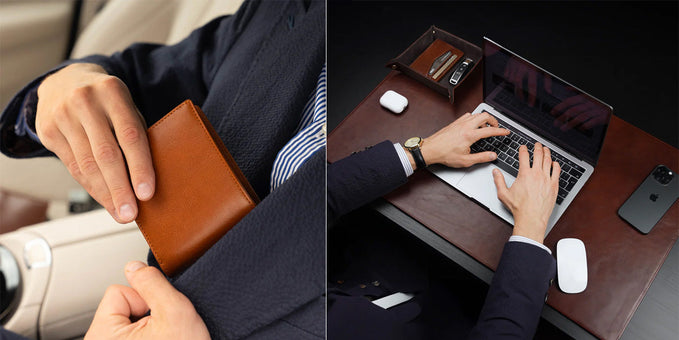Suede

Delicate yet daring, the world of suede offers a luxurious journey of tactile delight.
Did you know this sophisticated material has an intriguing history, one as rich and textured as its surface?
Prepare for a captivating exploration as we delve into the secrets of suede
What is suede fabric?
Suede is a kind of leather.
It can be sourced from any sort of animal that’s used to make normal leather.
The key difference between suede and other forms of leather is that suede fabric comes from the underside of animal skin.
However, most other kinds of leather come from the top side of animal skin.
The underside of animal skin is considerably softer to the touch than the outside. However, it is also less resistant to stains and the elements.
This means that suede is normally regarded as a luxury material. It may not have the durability of normal leather, but it is softer to the touch and more comfortable when you wear it against the skin.

Suede is much more permeable than conventional leather.
It does not have the waterproofing advantages of leather. This means it is better to wear suede garments indoors or when it’s unlikely that they will come into contact with challenging environmental conditions.
Although most other types of leather come from cow skin, suede is normally manufactured from lamb skin. Other kinds of animal skin including goat, deer and calf can be used to produce suede.
Many textile manufacturers have tried to create synthetic suede products. Some of these have been more impressive than others.
The idea is to cut down the impact on animals that produce leather and offset some of suede’s more negative attributes.
It may not be possible to fully replicate suede’s more desirable attributes, but synthetic alternatives to suede can be less expensive and longer lasting than the genuine product.
What is the quality level of suede?
Suede is a high-quality product overall. However, this is not really for the same reasons as other kinds of leather. It is more vulnerable to damage due to the way it is thinner and softer than these forms of leather.
However, many people find the softness and pliability offered by suede to be highly appealing.
The quality of suede is determined by factors like the animal the hide is derived from and its age. Sheep are the most common source of suede. However, mature cows produce a suede that’s generally regarded as less desirable.
Other things that can affect the quality of suede include the tanning process and whether the leather is split.
If leather is left intact as full-grain leather, this can be tougher and more durable, with the suede surface left on one side. However, this affects pliability. Suede is considered to be of much higher quality when it is split and supple.

What exactly does suede look like?
Suede has a luxurious feel and decorative look. The suede “side” of the material resembles densely packed short hairs. If suede has been brushed properly, it will have a consistent color and grain. If it is ruffled, it can look less dense and darker.
It’s also possible to dye suede. Whilst the natural color of suede is “tanned”, like most leathers, quality suede is available in various hues.
What are the advantages of suede leather?
Suede has many advantages over other forms of leather. Its look and feel have made it a highly desirable material. It is also durable thanks to the way it’s a product of hide. The nap also makes it rather unique.
What are the disadvantages of suede leather?
One of the drawbacks of suede leather is that it isn’t as durable as other forms of leather. It’s also not uncommon for the nap to trap dirt, oil and moisture.
This means suede is more prone to staining and damage. You can prevent this by taking proper care of the material.
Although suede can vary in quality terms, you can generally tell how good suede is by the way it feels.
What steps can I take to care for suede?
Most people know that they shouldn’t add water to suede. Other steps you can take to protect suede include using a sealant.
A suede brush or a dry, clean toothbrush can be used to maintain the freshness of the nap.
You can also treat wet stains with talcum powder. If a stain has already appeared, you may be able to treat it with a small amount of white vinegar. A professional cleaner can also help if you do need outside assistance.

History of Suede
The term “suede” comes from the French term “gants de Suede”. This means “gloves of Sweden.”
During France’s Romantic period, imports of Swedish leather became very popular with nobility. Swedish leather artisans came up with a way to use the soft inner skin of animals to create very soft women’s gloves rather than the rougher outer hide of animals.
Suede production was only used for gloves for many years. However, Swedish and other European artisans soon realized the possibilities of suede beyond just glove production.
It wasn’t too long before suede was used to make shoes, bags, jackets, and many other products that are now heavily associated with suede.
Suede production may be a relatively recent practice, but animal hides have been used to manufacture clothes and accessories for thousands of years.
Evidence from the prehistoric era shows that Neolithic people used animal hides as their main source of textiles. Leather and hides are still frequently used to make fabric today.
The key difference between leather made today and in the distant past is that there are more leather products on the market, and a greater level of technical skill is now used to make the leather materials of the modern era.
What are the key attributes of suede?
The fuzzy finish of suede is often described as “napped”. Whilst most other kinds of leather are smooth, many people say suede has a cotton-like feel that’s different to other animal skins.
Suede has a matte appearance whilst normal leather is glossy.
Normal leather is waterproof, whilst suede is incredibly permeable and can stain with relative ease.
Suede’s thinness makes it ideal for delicate textile applications. Suede is also famously hard to clean, and products made from this material can easily be ruined if you put them inside your washing machine.
It’s common for suede product owners to have them cleaned professionally so they stay in good condition.

How is suede fabric manufactured?
The process of manufacturing suede starts when the animal used to make the fabric is slaughtered.
The animal is then skinned before the hide is dried.
After the hide has dried fully, a natural chemical called lime is deployed to remove all the hair follicles from it.
The hide is then exposed to natural enzymes known as tannins. These make the hide inert and turn it into leather.
If tannins were not used, the hide used to create the leather would simply decompose over time like other animal products.
Tannins stop this decomposition from happening. The process of applying tannin is known as “tanning”.
How is the leather finished?
By this stage, the leather required to manufacture suede will be more or less finished.
Nonetheless, a few other processes must take place to ensure the fabric can be recognized as suede.
A blend of oils, salts and other natural compounds will be used to treat the leather and make it more durable. Synthetic chemicals can also be used to make the product even more durable.
The leather will need to be split and thinned. This creates the nappy exterior texture which makes suede such a desirable product.
Finally, a texturing process is used to add softness and comfort to the material.
What are the final processes?
After the closing texturing process, the suede fabric can be made into garments, shoes and accessories. It’s not uncommon for suede to be dyed before it is sold to garment and accessory manufacturers.
Normal leather can be very tough to dye, but the unique texture of suede makes this easier. This is because it can bond very well to various artificial and natural dyes.
Suede is normally sold by the yard once dyeing is complete. It can be cut and sewn to make final products which can be then sold to consumers.
However, some manufacturers prefer to apply an extra final waterproof finish before items are sold to customers.

What is suede fabric used for?
Suede fabric is used for various accessory and apparel applications.
As this fabric is famously delicate, suede isn’t generally used in industrial applications. Suede remains a very popular fabric in shoe production.
Suede is grey or light brown in its natural state, but it can also be dyed green, yellow, blue, red or any other color of your choosing.
Suede fabric is only useful for dress shoes. As this fabric is delicate, can absorb water and can stain with ease, it’s not always useful for outdoor shoe applications.
If you want to keep suede shoes looking presentable, regular upkeep is essential. This has caused many suede fans to seek out synthetic alternatives which don’t need as much maintenance and can be washed in machines.
Suede is also used to make jackets and other kinds of outerwear. However, it’s important to remember that suede is much better for outerwear in cool weather. This is because the fabric can easily become sodden and stained. It’s not ideal for rainy and snowy conditions.
Suede is also a popular material for making designer handbags. Its softness and unique texture make it highly desirable.
Suede handbags aren’t supposed to be used every day or in heavy-duty situations as they can wear quite quickly. If you use suede products sparingly, this will protect their quality and longevity.
The material is still sometimes used to make gloves, but other materials have surpassed it in this area.
Suede fabrics can also be used to make high-end belts, jackets, designer hats and automobile seat covers. Many car owners do prefer synthetic suede alternatives as they tend to be more durable and resistant to stains.
Related leather articles:
- Leather
- Faux leather
- Vegan leather
- Bonded leather
- Genuine leather
- Pleather
- Top grain leather
- Vegetable tanned leather
- What is artificial leather?
- What is full grain leather
- Mushroom leather
- Napa leather
- Pebbled leather
Where is suede fabric manufactured?
Although some people presume China is a leading producer of suede due to its association with leather products, evidence suggests that Europe actually has the biggest market share when it comes to the production of this material.
Nonetheless, China is the world’s biggest textile market. Other growing markets in regions like South America and South East Asia are likely to continue driving the demand for suede.
Although synthetic alternatives are popular, suede’s unique attributes mean it is likely to remain very popular.
What is the cost of suede fabric?
The expense of suede fabric per yard can depend on factors like its quality and how it’s made. Nonetheless, natural suede fabric tends to cost between $30-40 per yard.
Synthetic suede tends to be much cheaper than genuine suede. This has helped it to become very popular.
Some kinds of synthetic suede cost between $8-12 per yard. This has made suede alternatives including Ultrasuede and Alcantara to become very accessible to small and growing clothes and accessory producers who don’t have a great deal of capital to work with.
What different kinds of suede fabric are available?
There are some alternatives to the fabric that are referred to as suede in some circumstances. Only animal-derived nappy leather can be regarded as genuine suede. One of the first popular suede alternatives to appear on the market was Ultrasuede.
This was first developed in the early 1970s by a Japanese scientist called Miyoshi Okamoto. Most Ultrasuede is made of 80% polyester microfiber and 20% polyurethane plastic. It is possible to wash this kind of synthetic suede in a washing machine. You can also tumble dry it.
A trade name for a material like Ultrasuede is Alcantara. This was first developed by Japanese Toray Industries and Alcantara in a joint venture. This material is virtually identical to Ultrasuede, and it is machine-washable.
Ultrasuede is more frequently used in industrial and general consumer applications. Alcantara tends to be found in upmarket vehicle interiors and designer handbag lining.
Silk can be put through a chemical process which makes its texture similar to suede. Suede silk comes with all the desirable attributes of silk, but it can be machine washed unlike normal suede.
Sueded cotton also undergoes a chemical process which makes its exterior surface rougher so it resembles silk. This material can also be washed in a washing machine.
Read these articles next:
- Leather grades
- How is leather made
- Leather tanning
- Leather guide for beginners
- What is leather patina
- How to clean leather bag
- Best leather laptop bags for men
- Best leather backpacks
What is the impact of suede fabric on the environment?
Suede fabric doesn’t have a huge impact on the environment. As it is a natural animal fiber, it is biodegradable. This means suede does not build up in the Earth’s delicate ecosystems or contribute to the world’s microfiber crisis.
Nonetheless, some animal rights campaigners have shown concern about how animals are treated when suede fabric is produced. There are concerns about the way that animals are killed so leather fabrics can be derived.
The vast majority of the time, the other parts of the animal are also used when leather is harvested. However, the remainder of the animal is sometimes discarded.
The production of animals to make leather is only environmentally sustainable when the whole animal is used. Animals used to make leather including goats, sheep and cows use up vast amounts of food and water.
The breeding of bigger animals can harm the soil and other environmental conditions if the right land stewardship techniques are not adhered to.
Nonetheless, the production of leather products like suede is amongst the most eco-friendly forms of textile production.
The cultivation of plant-based fibers normally requires the use of fertilizers and chemical pesticides, and the production of synthetic fibers normally depends on fossil fuels. These fibers aren’t biodegradable.
As animal fibers like suede are biodegradable and renewable, they only have a modest impact on the environment if the right production and breeding techniques are complied with.
Suede production is not inherently environmentally sustainable. However, producers of this fiber need to be held to strict organic farming techniques so any avoidable negative environmental impact can be avoided.
Related articles:
- PU leather
- Bonded leather vs Faux leather
- Italian leather
- How to tell if leather is real
- Buffalo leather
- Suede vs Leather
- What is Real Leather
- Pu Leather vs Faux Leather
- Alternative Leather
- Chrome Tan Leather
Conclusion
We hope you enjoyed our article on suede.
If you have any questions or comments, contact us at info@vonbaer.com, or leave them in the comments.
Want to read more? Check out our Leather pages here

Author: Albert Varkki
Albert Varkki is the co-founder of Von Baer. He understands leather products as a consumer, supplier, and a manufacturer, helping you with the inside knowledge you need, to choose the perfect leather product for you.
We strive for the highest editorial standards, and to only publish accurate information on our website.
Leave a Comment
Your email address will not be published.






